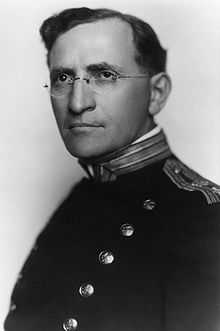Joseph Goldberger
| Joseph Goldberger | |
|---|---|
 Portrait of epidemiologist and U.S. Public Health Service physician Dr. Joseph Goldberger. | |
| Born |
July 16, 1874 Girált, Hungary |
| Died |
January 17, 1929 (aged 54) Washington, D.C., United States |
| Nationality | Hungarian-American |
| Fields | Epidemiology |
| Institutions | United States Public Health Service |
Joseph Goldberger (Hungarian: Goldberger József) (July 16, 1874 – January 17, 1929) was an American physician and epidemiologist employed in the United States Public Health Service (PHS). He was an advocate for scientific and social recognition of the links between poverty and disease.[1] He was nominated five times for the Nobel Prize for his work on the etiology of pellagra.
Biography
Early life
Goldberger was born in Girált, Hungary (now in Slovakia) in a Jewish family. The youngest of six children, he emigrated to the U.S. with his parents in 1883, eventually settling in Manhattan's Lower East Side. After completing his secondary education, Goldberger entered the City College of New York intending to pursue an engineering career. After a chance encounter in 1892, however, Goldberger became interested in medicine and transferred to the Bellevue Hospital Medical College (now the New York University School of Medicine), receiving his M.D. degree in 1895.[2]
Professional career
Setting up a private medical practice in Wilkes-Barre, Pennsylvania, Goldberger soon became intellectually restless.[3] He joined the Public Health Service in 1899, serving first post at the Port of New York, where he conducted health inspections of newly arrived immigrants.
From 1902–1906, Goldberger held a number of epidemiology posts—in Mexico, Puerto Rico, Mississippi and Louisiana. He was involved the Public Health Service's efforts to combat yellow fever, typhus, dengue fever, and typhoid fever. He gave a particularly noted lecture in Boston, Massachusetts on the effects of parasites in disease transmission. In 1909, Goldberger published his research on Schamberg disease, an acarine mite-based parasitic infection common among poor, inner-city populations. He also worked with John F. Anderson investigating the transmission of measles and typhus.[3]
Pellagra
In 1914, Goldberger was asked by US Surgeon General Rupert Blue to investigate pellagra, then an endemic disease in the Southern US.[4] Goldberger's theory that pellagra was associated with diet contradicted the commonly held medical opinion that pellagra was an infectious disease.[5] After multiple restricted-diet experiments on prisoners over several years, Goldberger was able to demonstrate that individuals who consumed heavily corn-based diets (to the virtual exclusion of other foods) were at a greatly increased risk of contracting pellagra.[3][4][6]
Despite his careful experiments, Goldberger's discovery proved socially and politically unacceptable, and he made little progress in gaining support for the treating of pellagra.[3] Conrad Elvehjem discovered the specific mechanism—that pellagra is caused by a dietary lack of the B vitamin niacin along with reduced levels of the essential amino acid tryptophan—in 1937.[7]
Joseph Goldberger died on January 19, 1929 from renal cell carcinoma.[4]
Legacy
- Goldberger was nominated five times for the Nobel Prize.[citation needed]
- Upon his death, Goldberger's wife received a $125-a-month pension thanks to a special congressional bill that recognized the value of his work.[citation needed]
- In 1940, John Nesbitt produced a short film about Goldberger titled A Way in the Wilderness, directed by Fred Zinnemann and starring Shepperd Strudwick.[8]
- The story of Goldberger's research on pellagra was featured on the Science Channel TV show, Dark Matters: Twisted But True, premiering: August 4, 2012 at 10PM e/p.[9]
- The radio program Cavalcade of America in 1940 had an episode called "The Red Death" about Goldberger's research on pellagra starring Ray Collins and Agnes Moorehead.[citation needed]
- His papers are held at the National Library of Medicine in Bethesda, Maryland.[10]
References
- ↑ Evans BK; Feinstein AR. (1 September 1994). "Joseph Goldberger: an unsung hero of American clinical epidemiology.". Ann Intern Med. 121 (5): 372–375. PMID 8042827.
- ↑ "Goldberger, Joseph". faqs.org. Retrieved 2008-07-14.
- ↑ 3.0 3.1 3.2 3.3 Parsons RP (1943). Trail to light: A biography of Joseph Goldberger. Bobbs-Merrill. ASIN B0007DYTFM.
- ↑ 4.0 4.1 4.2 "Dr. Joseph Goldberger and the War on Pellagra". NIH Archives. Retrieved 2007-01-23.
- ↑ Bollet A (1992). "Politics and pellagra: the epidemic of pellagra in the U.S. in the early twentieth century". Yale J Biol Med 65 (3): 211–21. PMC 2589605. PMID 1285449.
- ↑ Goldberger J, Wheeler GA (1915). "Experimental pellagra in the human subject brought about by a restricted diet". Public Health Reports 30: 3336.
- ↑ Koehn CJ, Elvehjem CA (1 May 1937). "Further studies on the concentration of the antipellagra factor". J Biol Chem 118 (3): 693–699.
- ↑ A Way in the Wilderness (Motion picture). 1940.
- ↑ Dark Matters (2012-09-20). "Dark Matters: Amnesiac, Party Poopers, Risky Radiation : Videos : Science Channel". Science.discovery.com. Retrieved 2013-12-17.
- ↑ "Joseph Goldberger Papers 1909-1940". National Library of Medicine.
|